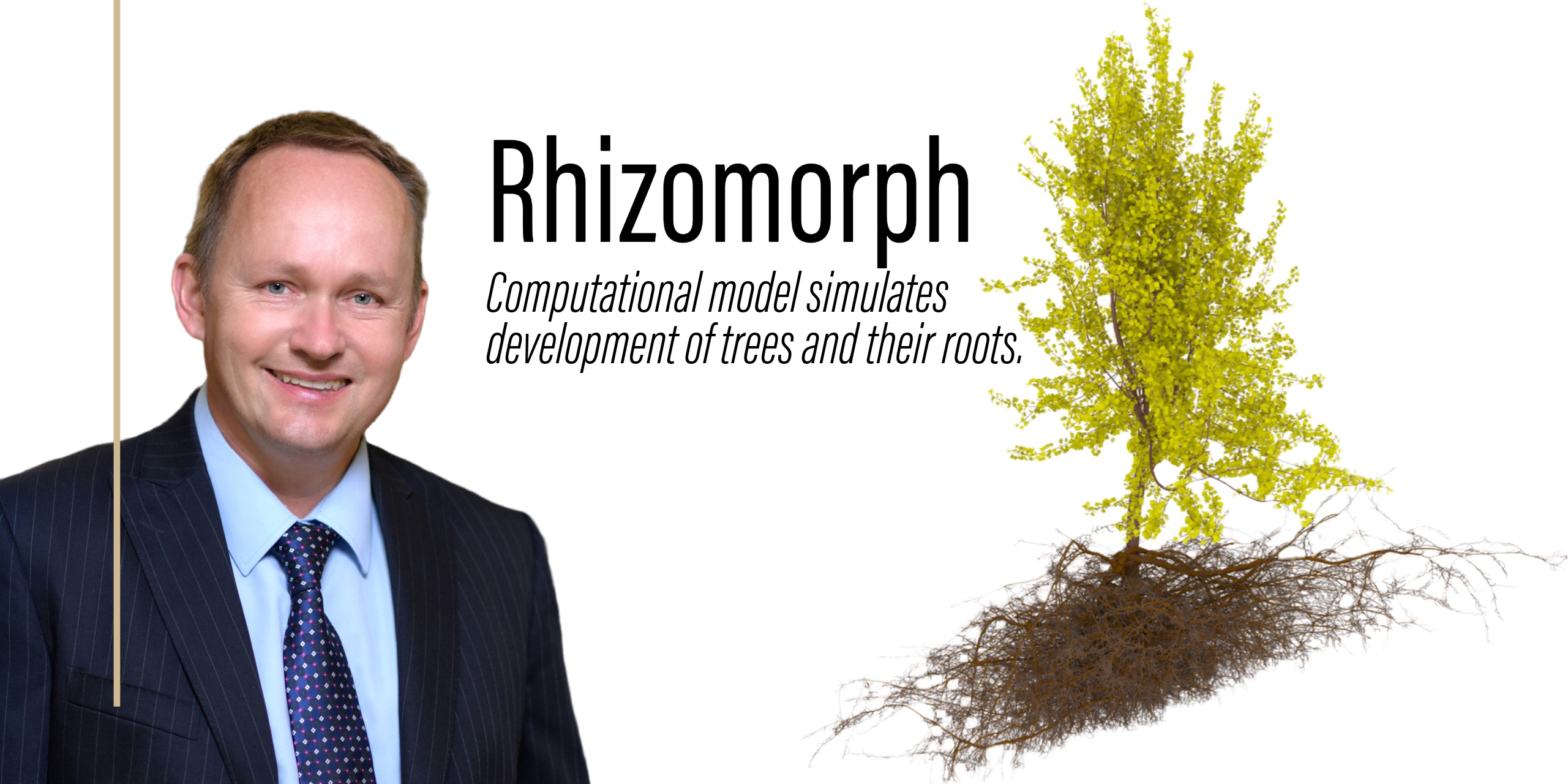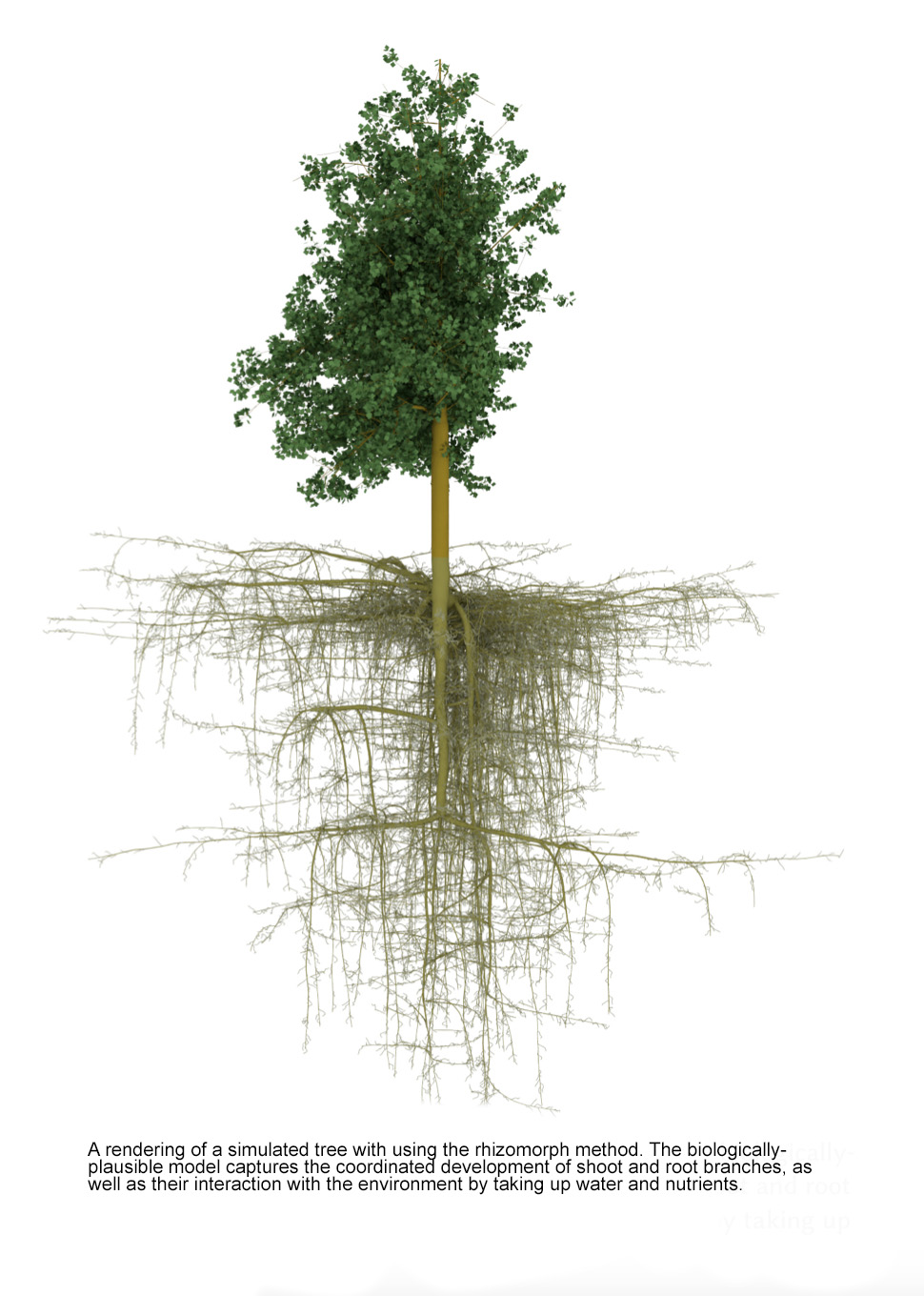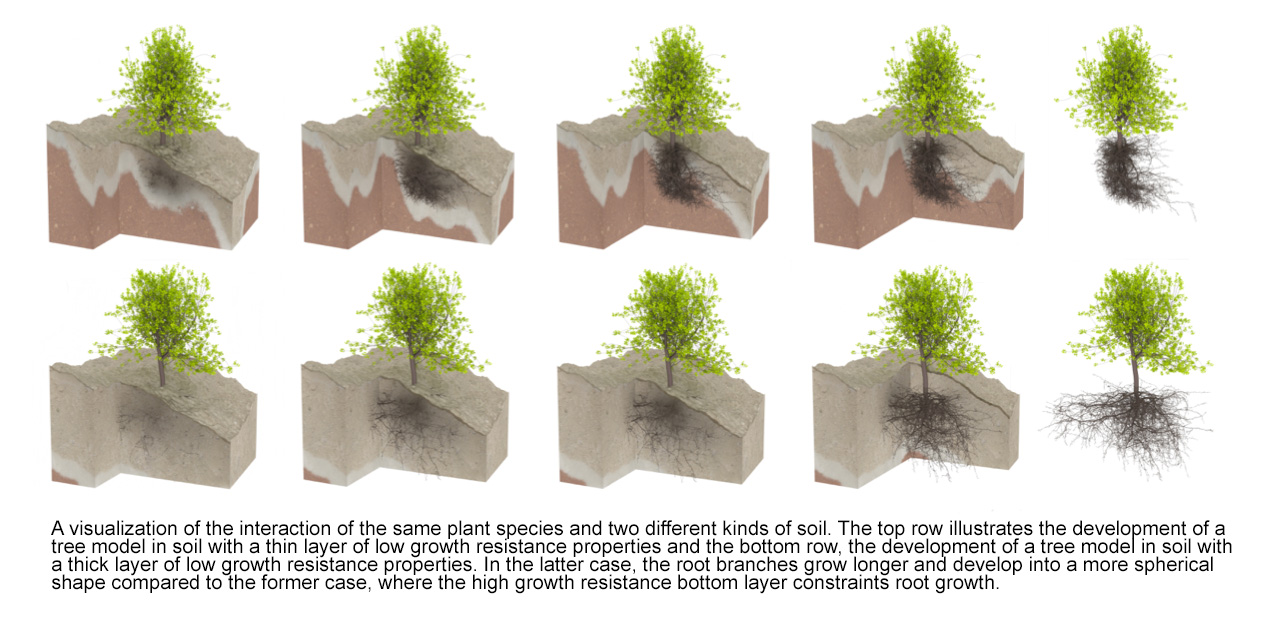Getting to the root of the problem in tree digital twin models
07-20-2023

Professor Bedrich Benes and colleagues have developed the rhizomorp model which simulates 3D development of trees and their roots.
A new computational model simulates the coordinated 3D development of trees and their roots.
Trees have immeasurable societal benefits. They provide wood, absorb carbon dioxide, shelter animals and insects, but also provide shade and space for people to relax.

Although forests have been studied and observed for millennia, there are still many open questions to their growth and health. One of them is understanding the way trees consume resources. While tree digital twins (computer models) that simulate branch competition for resources exist, root modeling and interaction with nutrients is still lacking.
Researchers Bosheng Li and Bedrich Benes from Purdue University, together with their collaborators Wojtek Pałubicki from Adam Mickiewicz University Poland, Soeren Pirk from Adobe Research and the Christian-Albrechts-University in Kiel, Germany, and Jonathan Klein and Dominik Michels from KAUST, Saudi Arabia, developed a novel interactive 3D model, called Rhizomorph, that simulates the complex interplay of the coordinated development of tree roots and their response to water and nutrients and the upper canopy and its response to light.
The rhizomorph model will be presented at the annual ACM conference Siggraph in Los Angeles in August 2023.
Taking soil, light, and water into account
The rhizomorph model simulates the coordinated development of shoots (upper tree canopy) and roots. It is an interactive computer model that integrates the layered soil model, where the water and nutrient flow is simulated by coupled differential equations that consider the 3D spatial and temporal domain.
“The paper successfully integrates modeling methods of trees and soil, substantially advancing the state of the art of tree modeling in an environmental context.”
– Przemysław Prusinkiewicz, professor emeritus of computer science, from the University of Calgary
The model simulates different structural compositions such as clay sand, loam, or humus. The nutrients and water flow through these materials and are absorbed by roots. The upper canopy of the tree reacts to light. The model integrates both inputs and uses a complex signaling mechanism that informs the roots and the shoots about the available energy that controls their development. The competition for resources results in the overall shape of both parts.
The authors show various examples of complex root systems: heart, lateral, sinker, taproot systems, roots reacting to varying nutrients, and soils.
“The paper successfully integrates modeling methods of trees and soil, substantially advancing the state of the art of tree modeling in an environmental context.” says Przemysław Prusinkiewicz, professor emeritus of computer science, from the University of Calgary and an expert in the field.
This realistic computer model that simulates the 3D development of trees with their roots will likely advance applications in simulations of complex ecosystems where trees are exposed to varying environmental conditions. The interactive speed of simulation of complex 3D shapes makes the model suitable for digital forestry applications and generates “what-if” scenarios where unknown or varying environmental conditions arise, as shown in the image below.
“A scenario I like to use is imagining the effects on a 3D forest model exposed to a changing climate,” said Benes. He added, “How will the tree and root shape be affected if there is not enough water? What happens when nutrients are not available, or the temperatures change?”
Existing models
Computer graphics has made significant strides in creating lifelike representations of trees and plants. In this pursuit, various techniques have been employed, with a particular focus on procedural modeling algorithms that incorporate biological principles.
These existing algorithms excel at generating intricate branching structures for individual trees, enhancing the realism of the models.
Unfortunately, many of these approaches have overlooked a crucial component: the root system of trees. Neglecting the representation of root systems not only compromises the visual authenticity of tree models but also disregards the vital role played by roots in the growth and development of trees.
Accurate representation
The inclusion of root systems in computer-generated tree models offers multiple benefits. It contributes to the overall visual fidelity of the models, ensuring a more accurate representation of real-life trees.
Furthermore, roots are integral to the survival and growth of trees, as they provide essential functions such as nutrient absorption, anchorage, and water uptake. By neglecting to model root systems, previous approaches have simplified this fundamental aspect of tree development.
Recognizing the significance of root systems, researchers in computer graphics are now exploring novel methodologies to incorporate root modeling into their algorithms. By integrating realistic root structures into their tree models, these advancements aim to achieve a more comprehensive and faithful representation of natural ecosystems in computer-generated graphics.

Li, J. Klein, D. L. Michels, B. Benes, S. Pirk, W. Pałubicki, Rhizomorph: The Coordinated Function of Shoots and Roots, ACM Transactions on Graphics (Proceedings of SIGGRAPH), 2023
Abstract
Computer graphics has dedicated a considerable amount of effort to generating realistic models of trees and plants. Many existing methods leverage procedural modeling algorithms -- that often consider biological findings -- to generate branching structures of individual trees. While the realism of tree models generated by these algorithms steadily increases, most approaches neglect to model the root system of trees. However, the root system not only adds to the visual realism of tree models but also plays an important role in the development of trees. In this paper, we advance tree modeling in the following ways: First, we define a physically-plausible soil model to simulate resource gradients, such as water and nutrients. Second, we propose a novel developmental procedural model for tree roots that enables us to emergently develop root systems that adapt to various soil types. Third, we define long-distance signaling to coordinate the development of shoots and roots. We show that our advanced procedural model of tree development enables -- for the first time -- the generation of trees with their root systems.
Bedrich Benes is a professor of computer science at Purdue University. He received his Ph.D. from Czech Technical University in Prague in 1998. He is the editor-in-chief of Graphical Models journal. Bedrich was papers co-chair of Eurographics 2019, and he was a program committee member of many conferences, including; Siggraph, Siggraph Asia, International Conference on Geometric Modeling and Processing, Symposium on Geometry Processing, Workshop on Procedural Content Generation in Games, Extreme Science and Engineering Discovery Environment (XSEDE), Computer Graphics International (CGI), Eurographics, and Eurographics Workshop on Natural Phenomena. Bedrich is a senior member of ACM and IEEE and a Fellow of the European Association for Computer Graphics (Eurographics). Bedrich works in generative methods for geometry synthesis, and his main focus is on tree modeling, procedural, inverse procedural modeling, simulation of natural phenomena and additive manufacturing. He has published over 190 research papers in the field. At Purdue, Benes founded the Purdue Computational Vegetation Group which focuses on digital twins of plants, particularly on digital tree models. Benes is a member of Purdue Center for Digital Forestry.
About the Department of Computer Science at Purdue University
Founded in 1962, the Department of Computer Science was created to be an innovative base of knowledge in the emerging field of computing as the first degree-awarding program in the United States. The department continues to advance the computer science industry through research. US News & Reports ranks Purdue CS #20 and #16 overall in graduate and undergraduate programs respectively, seventh in cybersecurity, 10th in software engineering, 13th in programming languages, data analytics, and computer systems, and 19th in artificial intelligence. Graduates of the program are able to solve complex and challenging problems in many fields. Our consistent success in an ever-changing landscape is reflected in the record undergraduate enrollment, increased faculty hiring, innovative research projects, and the creation of new academic programs. The increasing centrality of computer science in academic disciplines and society, and new research activities - centered around data science, artificial intelligence, programming languages, theoretical computer science, machine learning, and cybersecurity - are the future focus of the department. cs.purdue.edu
Writer: Emily Kinsell, emily@purdue.eduSource: Bedrich Benes, bbenes@purdue.edu